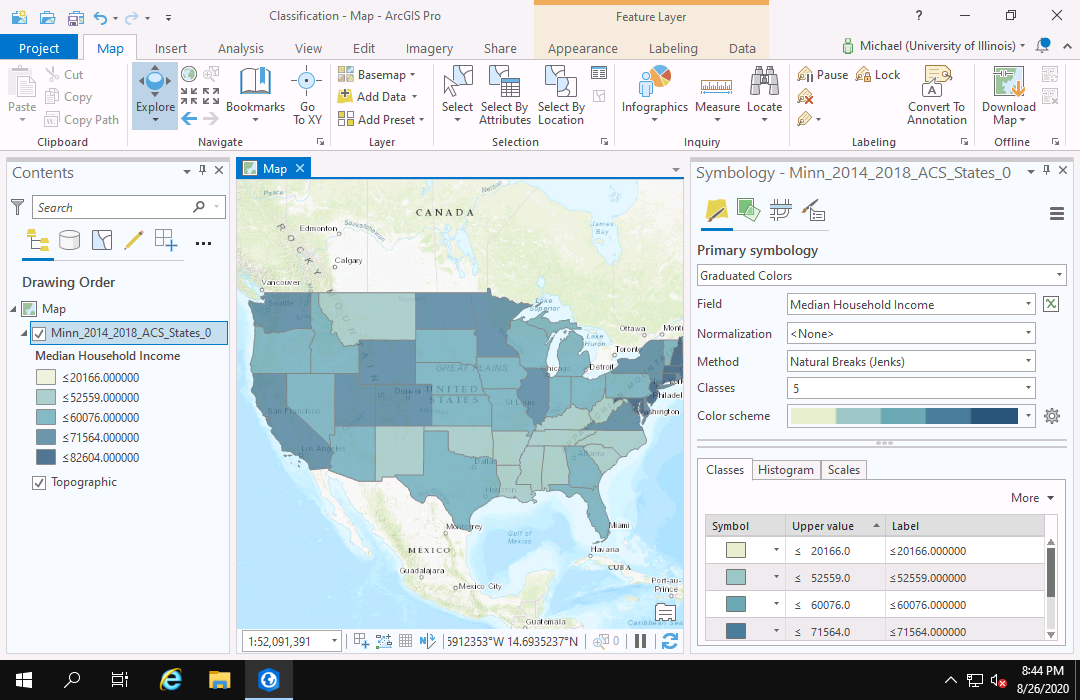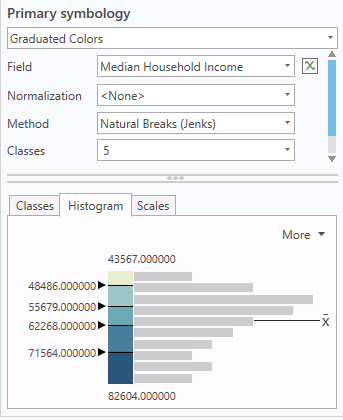How to Decide Which Data Classification to Use Arcgis
This is not a situation where ArcGIS can really help you decide on the best way to classify your data. For a geostatistical layer there are three standard ways in which data can be assigned to classes.

Image Classification Using The Arcgis Spatial Analyst Extension Arcmap Documentation
Question has been closedbut as a guideYou need to create the Accuracy Assessment Points.

. Data output from one tool is the input to subsequent tools where the goal is to produce a meaningful object-oriented feature class map. Creating a subset of bands for the classification. Click Select a Field and choose a field that contains numeric data.
This step processes your imagery into the classes based on the classification algorithm and the parameters specified. The number of classes is dependent on the objective of the analysis. Refer to the section Install deep learning dependencies of arcgislearn module for detailed explanation about deep learning dependencies.
On the Classify dialog box click Using numeric ranges. To display the Classify tool select the raster that is to be classified in the Contents pane then on the Imagery tab click the Classification Tools drop-down arrow. Generates a Kappa Index of Agreement between classified raster and ground truth data Index is based on how well the Classified Raster reflects the Ground Truth Points Kappa Index is expressed as a value between 0 and 1-The closer to 1 the value is the more accurate the reclassification was.
Click the Symbology tab. These include equal interval natural breaks quantile equal area and standard deviation. Open navigate to ceyesinthesky2weeksLouisanaAM select the LA_Riversmxd file and click Open.
The Classify tool allows you to choose from either unsupervised or supervised classification techniques to classify pixels or objects in a raster dataset. Complete the following steps to classify values using the Classify tool. Use the measures of accuracy the users accuracy producers accuracy and.
Launch ArcGIS by double-clicking its icon on your desktop or by clicking its icon in the or Launch Bar. This type of representation of data is known as classification. Image segmentation deriving analytical information about the segments and classification.
Then use that in the confusion matrix. Click the small circle with the four outward pointing arrows to enlarge any single chart. The rules by which the data is assigned to a class however require a bit of explanation.
To use only certain bands from an existing dataset for the classification create a new raster layer for them using the Make Raster Layer tool. After you have performed a supervised classification you may want to merge some of the classes into more generalized classes. Either use the Update Accuracy Assessment Point tool to compare this classification to previously created classifications or manually edit the points and visually assess a reference image.
Confusion Matrix Will you take the Red Cell or the Blue Cell. Launch ArcGIS Open the Louisiana Project File and Add a New Layer. A user can choose an appropriate architecture to train the model.
Right-click the geostatistical layer in the ArcMap table of contents that you want to classify and click Properties. The object-oriented feature extraction process is a workflow supported by tools covering three main functional areas. Segments exhibiting certain shapes spectral.
Work with your data and different possible classification schemes and document. Quantile classification creates grouping so that there are an even number of values in each grouping. And indeed you should never use the default classification without looking at your data and thinking about the phenomena the data represents.
The number of classes is dependent on the objective of the analysis. Segmentation and classification tools provide an approach to extracting features from imagery based on objects. Use the classified image as the input and choose Classified as the Target Field.
If you use the ArcGIS default of five categories you are dividing the features into five ranked categories by percentile. For example if you specify three classes for a field with values ranging from 0 to 300 ArcGIS for Power BI creates three classes with ranges of 0100 101200 and 201300. You can classify your data using unsupervised or supervised classification techniques.
Click inside the dashboard to interact with it. For a geostatistical layer there are three standard ways in which data can be assigned to classes. The Classification Wizard is disabled if the active map is a 3D scene or if the highlighted image is not a multiband image.
Use a digitised polygon of known classes Ground-Truth as the target field. In the Contents pane click the Options button next to a layer and click Classify. Hover your mouse over a column to see that data value.
To start create natural breaks on one of the maps. There are several different classification methods you can choose to organize your data when doing thematic mapping. First you need to calculate the average difference between the population density of the same areas in the two maps.
The rules by which the data is assigned to a class however require a bit of explanation. Click the same circle to reduce the size of the chart. For a geostatistical layer there are three standard ways in which data can be assigned to classes.
Data preparation and model training workflows for text classification using arcgislearntext is based on Hugging Face Transformers library. To use all bands in an image dataset in the classification add the image dataset to ArcMap and select the image layer on the Image Classification toolbar. Click the Method arrow and choose a.
Once you have the average difference you can use it when you create your breaks. Use the Compute Confusion Matrix tool to create a confusion matrix from the accuracy points. These objects are created via an image segmentation process where pixels in close proximity and having similar spectral characteristics are grouped together into a segment.
In the Equal Interval classification method each class has an equal range of values. Click the cursor arrow with lock icon to. Once its run choose the Update Accuracy.
Select the raster dataset to classify in the Contents pane to display the Imagery tab and be sure you are working in a 2D map. Note the break values that are created. Classifying data by setting a predefined classification method.
With this classification method you specify the number of classes and ArcGIS for Power BI automatically determines how to divide the data. The Classification Wizard is found in the Image Classification group on the Imagery tab. That is the difference between the high and low value is equal for each class.
This effectively creates a map showing the rank order of a variable. The rules by which the data is assigned to a class however require a bit of explanation. The number of classes is dependent on the objective of the analysis.

The Image Classification Wizard Arcgis Pro Documentation

No comments for "How to Decide Which Data Classification to Use Arcgis"
Post a Comment